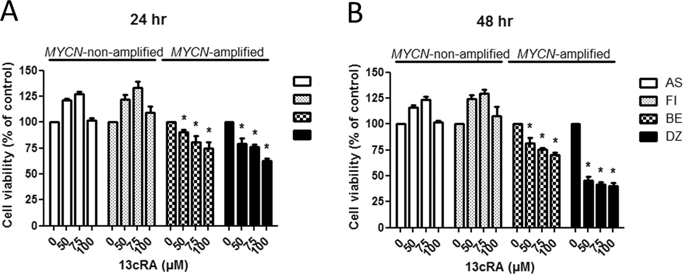当前位置:
X-MOL 学术
›
Lab. Invest.
›
论文详情
Our official English website, www.x-mol.net, welcomes your
feedback! (Note: you will need to create a separate account there.)
Immunomodulator polyinosinic-polycytidylic acid enhances the inhibitory effect of 13-cis-retinoic acid on neuroblastoma through a TLR3-related immunogenic-apoptotic response.
Laboratory Investigation ( IF 5.1 ) Pub Date : 2019-12-19 , DOI: 10.1038/s41374-019-0356-0 Hui-Ching Chuang,Hung-Yu Lin,Pei-Lin Liao,Chao-Cheng Huang,Li-Ling Lin,Wen-Ming Hsu,Jiin-Haur Chuang
Laboratory Investigation ( IF 5.1 ) Pub Date : 2019-12-19 , DOI: 10.1038/s41374-019-0356-0 Hui-Ching Chuang,Hung-Yu Lin,Pei-Lin Liao,Chao-Cheng Huang,Li-Ling Lin,Wen-Ming Hsu,Jiin-Haur Chuang

|
High-risk neuroblastoma is associated with low long-term survival rates due to recurrence or metastasis. Retinoids, including 13-cis-retinoic acid (13cRA), are commonly used for the treatment of high-risk neuroblastoma after myeloablative therapy; however, there are significant side effects and resistance rates. In this study, we demonstrated that 13cRA has a better antiproliferative effect in MYCN-amplified neuroblastoma cells than in MYCN-nonamplified neuroblastoma cells. In MYCN-amplified SK-N-DZ cells, 13cRA induced significant upregulation of toll-like receptor 3 (TLR3) and mitochondrial antiviral-signaling protein (MAVS) expression in a time-dependent manner. Furthermore, poly (I:C), a synthetic agonist of TLR3, effectively synergized with 13cRA to enhance antiproliferative effects through upregulation of the innate immune signaling and the mitochondrial stress response, leading to augmentation of the apoptotic response in 13cRA-responsive cancer cells. In addition, the 13cRA/poly (I:C) combination induced neural differentiation through activation of retinoic acid receptors beta (RAR-β), restoring expression of α-thalassemia/mental retardation syndrome X-linked (ATRX) protein, and inhibiting vessel formation, leading to retarded tumor growth in a mouse xenograft model. These results suggest that the combination of poly (I:C) and RA may provide synergistic therapeutic benefits for treatment of patients with high-risk neuroblastoma.
中文翻译:

免疫调节剂聚肌胞苷酸通过 TLR3 相关的免疫原性凋亡反应增强 13-顺式视黄酸对神经母细胞瘤的抑制作用。
由于复发或转移,高危神经母细胞瘤与低长期存活率相关。类视黄醇,包括 13-顺式视黄酸 (13cRA),常用于清髓治疗后高危神经母细胞瘤的治疗;但是,存在显着的副作用和耐药率。在这项研究中,我们证明 13cRA 在 MYCN 扩增的神经母细胞瘤细胞中比在 MYCN 非扩增的神经母细胞瘤细胞中具有更好的抗增殖作用。在 MYCN 扩增的 SK-N-DZ 细胞中,13cRA 以时间依赖的方式诱导 Toll 样受体 3 (TLR3) 和线粒体抗病毒信号蛋白 (MAVS) 表达的显着上调。此外,poly (I:C) 是一种 TLR3 的合成激动剂,与 13cRA 有效协同,通过上调先天免疫信号和线粒体应激反应增强抗增殖作用,从而增强 13cRA 反应性癌细胞的凋亡反应。此外,13cRA/poly (I:C) 组合通过激活视黄酸受体 β (RAR-β)、恢复 α-地中海贫血/智力低下综合征 X 连锁 (ATRX) 蛋白的表达和抑制血管来诱导神经分化形成,导致小鼠异种移植模型中的肿瘤生长迟缓。这些结果表明,聚 (I:C) 和 RA 的组合可能为治疗高危神经母细胞瘤患者提供协同治疗益处。13cRA/poly (I:C) 组合通过激活视黄酸受体 β (RAR-β)、恢复 α-地中海贫血/智力低下综合征 X 连锁 (ATRX) 蛋白的表达和抑制血管形成来诱导神经分化,导致在小鼠异种移植模型中延缓肿瘤生长。这些结果表明,聚 (I:C) 和 RA 的组合可能为治疗高危神经母细胞瘤患者提供协同治疗益处。13cRA/poly (I:C) 组合通过激活视黄酸受体 β (RAR-β)、恢复 α-地中海贫血/智力低下综合征 X 连锁 (ATRX) 蛋白的表达和抑制血管形成来诱导神经分化,导致在小鼠异种移植模型中延缓肿瘤生长。这些结果表明,聚 (I:C) 和 RA 的组合可能为治疗高危神经母细胞瘤患者提供协同治疗益处。
更新日期:2019-12-20
中文翻译:

免疫调节剂聚肌胞苷酸通过 TLR3 相关的免疫原性凋亡反应增强 13-顺式视黄酸对神经母细胞瘤的抑制作用。
由于复发或转移,高危神经母细胞瘤与低长期存活率相关。类视黄醇,包括 13-顺式视黄酸 (13cRA),常用于清髓治疗后高危神经母细胞瘤的治疗;但是,存在显着的副作用和耐药率。在这项研究中,我们证明 13cRA 在 MYCN 扩增的神经母细胞瘤细胞中比在 MYCN 非扩增的神经母细胞瘤细胞中具有更好的抗增殖作用。在 MYCN 扩增的 SK-N-DZ 细胞中,13cRA 以时间依赖的方式诱导 Toll 样受体 3 (TLR3) 和线粒体抗病毒信号蛋白 (MAVS) 表达的显着上调。此外,poly (I:C) 是一种 TLR3 的合成激动剂,与 13cRA 有效协同,通过上调先天免疫信号和线粒体应激反应增强抗增殖作用,从而增强 13cRA 反应性癌细胞的凋亡反应。此外,13cRA/poly (I:C) 组合通过激活视黄酸受体 β (RAR-β)、恢复 α-地中海贫血/智力低下综合征 X 连锁 (ATRX) 蛋白的表达和抑制血管来诱导神经分化形成,导致小鼠异种移植模型中的肿瘤生长迟缓。这些结果表明,聚 (I:C) 和 RA 的组合可能为治疗高危神经母细胞瘤患者提供协同治疗益处。13cRA/poly (I:C) 组合通过激活视黄酸受体 β (RAR-β)、恢复 α-地中海贫血/智力低下综合征 X 连锁 (ATRX) 蛋白的表达和抑制血管形成来诱导神经分化,导致在小鼠异种移植模型中延缓肿瘤生长。这些结果表明,聚 (I:C) 和 RA 的组合可能为治疗高危神经母细胞瘤患者提供协同治疗益处。13cRA/poly (I:C) 组合通过激活视黄酸受体 β (RAR-β)、恢复 α-地中海贫血/智力低下综合征 X 连锁 (ATRX) 蛋白的表达和抑制血管形成来诱导神经分化,导致在小鼠异种移植模型中延缓肿瘤生长。这些结果表明,聚 (I:C) 和 RA 的组合可能为治疗高危神经母细胞瘤患者提供协同治疗益处。







































 京公网安备 11010802027423号
京公网安备 11010802027423号